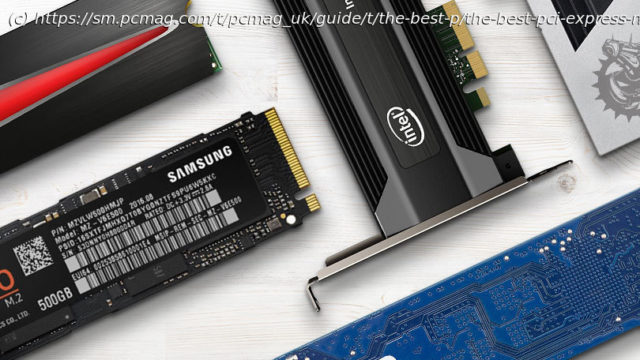Solid-state drives that adhere to the NVMe protocol are the fastest internal storage drives you can buy today for building a PC or upgrading certain laptops. Here’s how to shop for one with confidence, along with our top NVMe SSD picks from our deep-dive reviews.
Shopping for an SSD means facing a sea of acronyms. The trickiest of them are jagged reefs sticking out of the water, shaped like circuit boards and ready to run your upgrade aground if you’re not careful. “SSD,” standing for “solid-state drive,” is the one you probably know. An SSD is a storage drive made up purely of flash memory in modules called “NANDs,” and governed by a controller chip. Simple enough—but there is much complexity beneath the surface of those three letters. SSD navigation has gotten even more treacherous in the last few years, with the emergence of three key new things you need to know about when shopping for an SSD: M.2, PCI Express (or “PCIe”), and NVMe. All three are centered around making SSDs smaller or faster. They also make buying an SSD more complicated than ever. SSDs: Why They Are Changing Shapes Until recently, the typical SSD was a little slab, designed to fit into the same space in a laptop or PC that a hard drive would. (The lingo was “2.5-inch drive” for that size of SSD.) That’s changing nowadays. Almost all new desktop-PC motherboards, and the logic boards on many new laptops, incorporate slots meant for much smaller SSDs. That’s especially important in thin laptops, where interior space is so scarce. These slots are known as M.2 slots, and they accept M.2 SSDs that look like sticks of silicon chewing gum. Just about every new desktop motherboard these days has at least one such slot; some have two or three. And depending on the drive, that slim little stick of an SSD may be much faster than those bigger drives you are used to. Why did SSDs take so long to get so small? That’s a good question, with a simple answer. SSDs never needed to be that big in the first place, from a strict manufacturing point of view. “Classic” 2.5-inch SSDs have a lot of dead space inside, but they were designed that way to fit into existing bays in laptops and desktop PCs. In slimming down laptops and tablets to extremes, one thing came clear: That much-fatter kind of drive would have to go. An M.2 SSD reduces the SSD to its essentials: just a strip of a circuit board, studded with chips. Versus SSDs of the past, M.2 is much leaner and much easier to fit into tight spaces. First, a Bit About M.2 Most M.2 drives aren’t pretty; they tend to look like bare circuit boards with various silicon chips grafted on them, including the NAND modules that store your data. (Check out our guide to SSD lingo at Buying a Solid-State Drive: 20 Terms You Need to Know.) Some may be topped by a heat spreader or heat sink that is usually equal parts practical and decorative. The most important thing to know about M.2, though, is what it is and what it isn’t. Although M.2 is commonly referred to as an interface, that’s not the whole story. M.2 is also a shape or form factor of drive, though M.2 also governs the keying that lets a drive fit onto a motherboard. The data bus, or pathway, over which your data travels to and from an M.2 drive is a whole other matter, and it takes one of several forms. And that is where NVMe comes in. We’ll get to the significance of NVMe in a moment; first, let’s discuss the key physical traits of an M.2 drive that you need to understand. (The video below is also a good primer.) As we discuss in our parallel roundup, The Best M.2 Solid-State Drives, M.2 drives are differentiated by a four- or five-digit number listed in their specifications or names. The number is a measurement. It’s given in millimeters, with the first two digits being the drive’s width, and the second two or three digits telling you how long it is. In practice, all of the upgrader- or PC-builder-minded M.2 SSDs and slots we have seen to date have been 22mm wide, so you can expect this number to start with “22.” The most common lengths are 80mm (“M.2 Type-2280”) and 60mm (“M.2 Type-2260”). Drives as short as 42mm (“M.2 Type-2242”) or as long as 110mm (“M.2 Type-22110”) do exist, though. Why the differences in length? The longer the drive’s PCB, the more surface area it will have onto which chips can fit. Length mostly matters if fitting an M.2 drive into a laptop. Most desktop motherboards with M.2 slots have mounting points for multiple lengths of drive (usually,80mm,60mm, and 42mm, and sometimes 110mm), whereas most laptops fit just one size. Check the space available before you shop.M.2 drives in Type-2242, Type-2260, and Type-2280 sizes The length of an M.2 drive doesn’t always correlate 1:1 with drive capacity, but the bigger the stick, the more memory modules engineers can stuff onto a PCB of a given size, all else being equal. Because of space and density limits, most M.2 drives to date have topped out at 1TB, though 2TB,4TB, and even 8TB M.2 SSDs are now seeing the light of day. You’ll see four broad classes of capacity on most M.2 SSDs, with the capacities varying within the class according to how much data the drive maker has put aside for “overprovisioning” (essentially, a safety margin put aside for when the drive ages and some cells fail). These capacity classes are…120GB or 128GB240GB,250GB, or 256GB480GB,500GB, or 512GB960GB or 1TB Now, let’s reiterate an important point: A drive may be an M.2 stick of whatever length and capacity, but that doesn’t tell you about the bus that it makes use of. That detail is vital to know—just as important as making sure the drive’s length works in the space you have.






